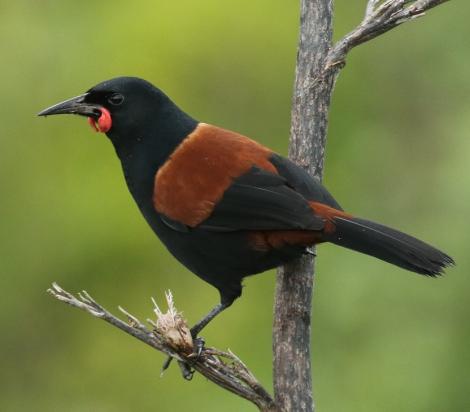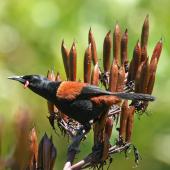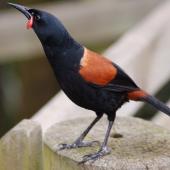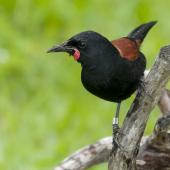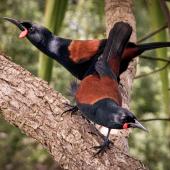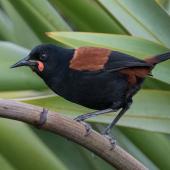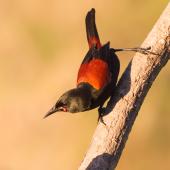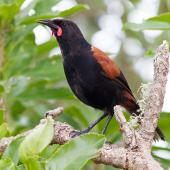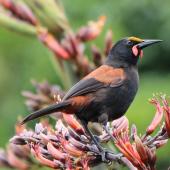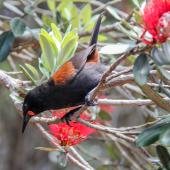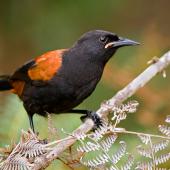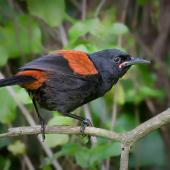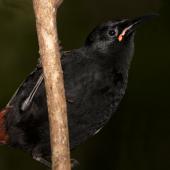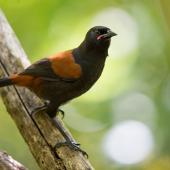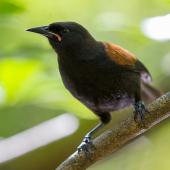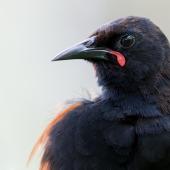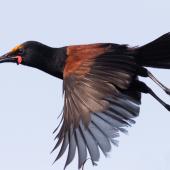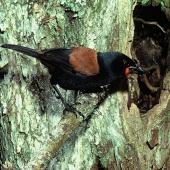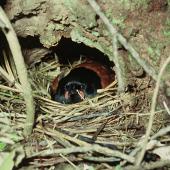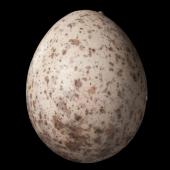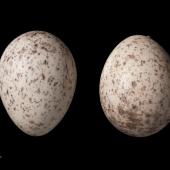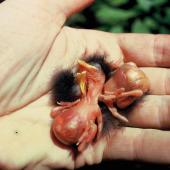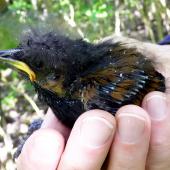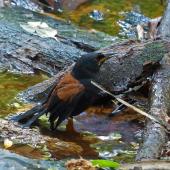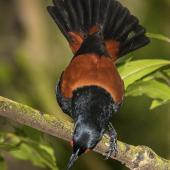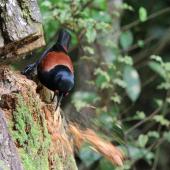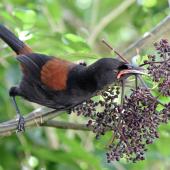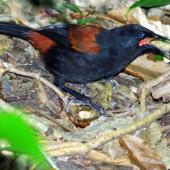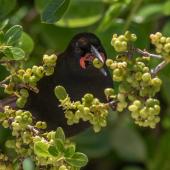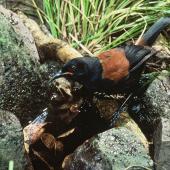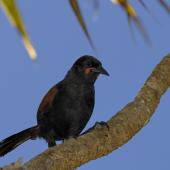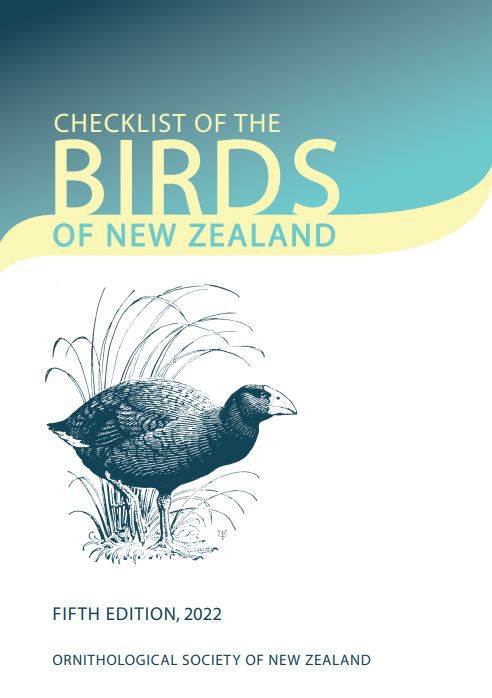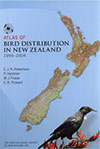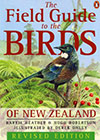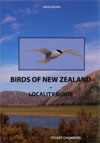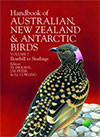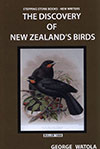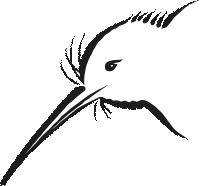North Island saddleback | Tīeke
Philesturnus rufusater (Lesson, 1828)
Order: Passeriformes
Family: Callaeidae
Other names: tieke, tiaki
Geographical variation: Sometimes considered conspecific with South Island saddleback P. carunculatus, which has name priority.
North Island saddlebacks are conspicuous and easily observed in regenerating scrub, forests and coastal forests. They call frequently, particularly in response to disturbance, and are very active, noisy foragers. They are about the size of a European blackbird. Saddlebacks were widespread at European contact, but rapidly declined on the mainland following the introduction of predatory mammals, especially ship rats and stoats. By the early 1900s, North Island saddlebacks were confined to a single population on Hen Island (Taranga) off the northeast coast of the North Island. A series of successful translocations was initiated by the New Zealand Wildlife Service in the 1960s. There are now 18 island populations, including the natural population on Hen Island, a population established through natural dispersal on Coppermine Island, and 16 translocated island populations, plus another six at predator-fenced mainland sites.
Identification
North Island saddlebacks have striking black plumage, a rufous chestnut saddle across their back, bright reddish-orange wattles (that get larger with age) and a thin pale yellow band on the leading edge of the saddle. Sexes are alike, although males usually have larger wattles than females of the same age. Juveniles are similar but their plumage lacks the sheen of adults, with dusty brown tips on black body feathers, the gold band is absent, and they have small wattles.
Voice: a loud chattering call cheet te-te-te-te is uttered throughout the day. Territorial male birds sing male rhythmical song which is characterised by 2-4 introductory chips followed by a series of highly stereotyped and repeated phrases. Over 200 different types of male rhythmical song have been recorded, with song diversity and distribution correlating with translocation history. Male and female birds also give sexually dimorphic quiet calls which are very soft and flute like.
Similar species: the closely related South Island saddleback now confined to small islands and one fenced sanctuary, all south of Cook Strait.
Distribution
The single remaining natural population of around 500 birds is on Hen Island. There are translocated populations on Whatupuke (established in 1964), Red Mercury (1966), Cuvier (1968), Lady Alice (1971), Stanley (1977), Little Barrier (1984-1988), Tiritiri Matangi (1984), Kapiti (1987-1989), Mokoia (1992), Moutuhora (1999), Motuihe (2005), Rangitoto and Motutapu Islands (2011-2012), Rotoroa (2014), Moturua (2015), and Urupukapuka (2015) Islands. Coppermine Island was naturally colonised from Whatupuke Island in the 1970s. There are mainland populations at six fenced sanctuaries, Zealandia/Karori Sanctuary (2002), Bushy Park/Tarapurihi (2006),Tawharanui Open Sanctuary (2012), Maungatautari (2013), Rotokare (2014), and Shakespear Open Sanctuary (2018).
Habitat
North Island saddlebacks frequent coastal and inland forests, particularly scrubby regenerating areas, ranging from sea level to more than 600 m above sea level.
Population
North Island saddlebacks can be very abundant in suitable habitat free of introduced mammals. Recent population estimates suggest there are more than 7000 birds across all populations. However, many of the island estimates are not based on formal counts and the actual number is likely to be much higher.
Threats and conservation
Cavity-roosting and nesting behaviour makes North Island saddlebacks extremely vulnerable to predation by introduced mammals, especially stoats. Therefore, they can only exist at sites where exotic mammalian pests are either completely excluded or are at zero density. Translocation has been essential for the conservation management of North Island saddlebacks (see Distribution).
Breeding
Typically spring and summer breeders. Female North Island saddlebacks build a cup nest of vegetation in tree cavities, rock crevices, tree fern crowns, epiphytes and in dense ground level vegetation. Artificial nest boxes are used on some islands. The clutch size is 1-4 and they can rear up to four broods in a season (typically 1-2 in established populations). The female incubates and broods but both parents feed and care for young.
Behaviour and ecology
North Island saddlebacks are extremely active foragers utilising the forest floor to the canopy. They often have other species in attendance whilst feeding, particularly fantails and whiteheads. They use their bill as an anvil to chip away at rotten wood, investigate under cabbage tree skirts and epiphytes, burrow into leaf litter and glean branches, trunks and leaves. They are relatively weak fliers but have very stout legs that are used whilst feeding and for bounding through vegetation.
Food
Invertebrates, fruits and nectar.
Weblinks
https://www.doc.govt.nz/nature/native-animals/birds/birds-a-z/saddleback-tieke/
References
Heather, B.D.; Robertson, H.A. 1996 (rev 2000). The field guide to the birds of New Zealand. Viking, Auckland.
Higgins,P.J.; Peter, J.M.; Cowling, S.J. (eds.) 2006. Handbook of Australian, New Zealand and Antarctic birds. Vol. 7, boatbill to starlings. Oxford University Press, Melbourne.
Hooson, S.; Jamieson, I.G. 2003. The distribution and current status of New Zealand saddleback Philesturnus carunculatus. Bird Conservation International 13: 79-95.
Lovegrove, T.G. 1996. Island releases of saddlebacks Philesturnus carunculatus in New Zealand. Biological Conservation 77: 151-157.
Miskelly, C.M.; Powlesland, R.G. 2013. Conservation translocations of New Zealand birds, 1863-2012. Notornis 60: 3-28.
Parker, K.A.; Anderson, M.J.; Jenkins, P.F.; Brunton, D.H. 2012. The effects of translocation-induced isolation and fragmentation on the cultural evolution of bird song. Ecology Letters 15: 778-785.
Parker, K.A., Ludwig, K., King, T.M., Brunton, D.H., Scofield, R.P., Jamieson, I.G. 2014. Differences in vocalisations, morphology and mtDNA support species status for New Zealand saddleback Philesturnus spp. New Zealand Journal of Zoology 41: 79-94.
Recommended citation
Parker, K.A. 2013 [updated 2022]. North Island saddleback | tīeke. In Miskelly, C.M. (ed.) New Zealand Birds Online. www.nzbirdsonline.org.nz
North Island saddleback | Tīeke
- Social structure
- monogamous
- Breeding season
-
- Jul
- Aug
- Sep
- Oct
- Nov
- Dec
- Jan
- Feb
- Mar
- Apr
- May
- Jun
- Nest type
- burrow, cliff ledge, ground-level hollow, hole in building, raised platform, rock crevice, tree hole, woven cup
- Nest description
- Typically an open cup nest built of rootlets, grasses, leaves and small twigs lined with fern scale or fine grasses.
- Nest height (min)
- 0 m
- Nest height (max)
- 18 m
- Maximum number of successful broods
- 4
- Clutch size (mean)
- 2.5
- Clutch size (min)
- 1
- Clutch size (max)
- 4
- Mean egg dimensions (length)
- 29 mm
- Mean egg dimensions (width)
- 22 mm
- Egg colour
- Grey to pinkish purple grey, more rarely white with darker spots and or blotches, typically in various shades of brown, mauve or purple.
- Egg laying dates
-
- Jul
- Aug
- Sep
- Oct
- Nov
- Dec
- Jan
- Feb
- Mar
- Apr
- May
- Jun
- Interval between eggs in a clutch
- 1 day days
- Incubation behaviour
- female only
- Incubation length (mean)
- 18 days
- Nestling type
- altricial
- Nestling period (min)
- 22 days
- Nestling period (max)
- 27 days
- Age at fledging (min)
- 22 days
- Age at fledging (max)
- 27 days
- Age at independence (min)
- 50 days
- Age at independence (max)
- 69 days
- Age at first breeding (typical)
- 1 year
- Age at first breeding (min)
- 1 years
- Maximum longevity
- 21 years
- Maximum dispersal
- Greater than 5 km




